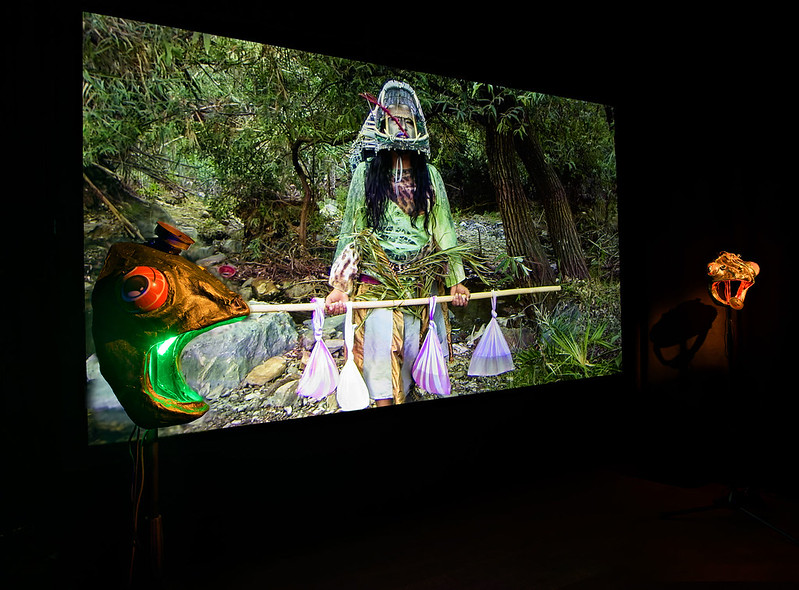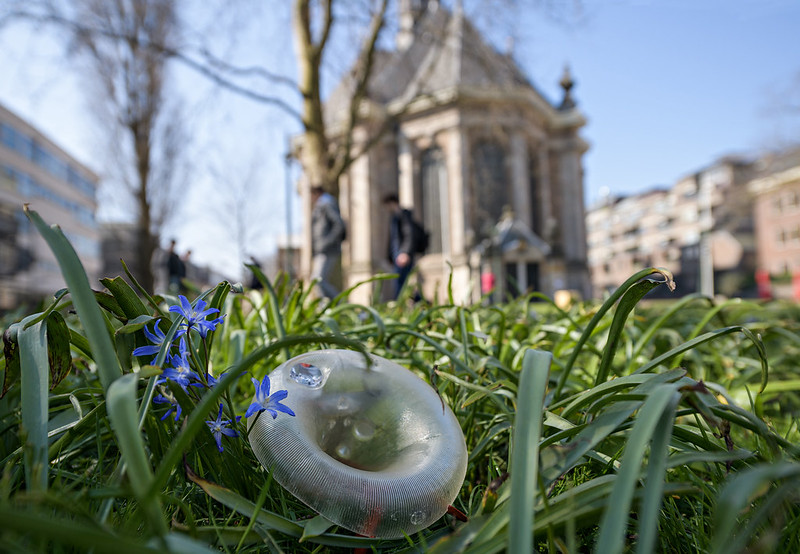Text by Agata Kik

To move towards and to simultaneously move with; to aim directly and at the same time to be led; freedom of flow must mean interdependence, and to go on, one needs the other to become oneself. But there will always be more than two. While based on duality, this reality, rather than pure light, more often arrives at us in multiples.
The 12th and the most extensive festival edition of Rewire this year, hosting more than 200 individual events between 6 to 9 April 2023 across the Hague (The Netherlands), took on the theme of (inter)relations. Advocating new forms of collaboration rather than polarisation between different humans and their cultures, nature and technology, past and present. The festival’s curatorial framework underscored fluidity, porosity and collapse of binary boundaries as the only way to progress on this entangled earth.
Carried on the train clatter, I arrive in Amsterdam to immediately immerse in the cacophony of train station announcements, deliberately made so oblique, so out of synch. Numb and deafened, switching to the inner ear, I decipher that all the trains between the capital and the Hague have been suspended for the next few days due to a railroad accident in between.
Unhurried and hesitantly, I find an alternative way to get to the Dutch coast in the end. With a silent smile, the wind slapping my face, I wake up and, in pouring rain walk around the seaside city of the country’s seat of government. I follow the streams of soaking wet-coated men. Anyway, everything begins with the environment.
The Soundscape Speaks, an audio piece by Hildegard Westerkamp, is the most magical and the warmest welcoming Rewire could have on offer. In the Basement of the festival hub at The Grey Space in the Middle, I find a red-lit ambience with low ceilings and a cushioned colourful carpet inviting me to let go, and so immediately I lie down.
I feel as if in a tent with fellow members deserted in the middle of a dreamy desert surrounded by a night’s dry darkness and ghostly cosiness. With water drops like mallets hitting the membrane, Westercamp’s sound work consists of field recordings and contrasting compositional approaches that act as a ‘fluid stream of listening-thinking-feeling’.
Revisiting our relationship with the environment, earlier inspired by her experiments at the Vancouver Co-op Radio, Westerkamp encourages a deeper way of being in the world through her listening and soundwalking practices while recording sounds of her life and the Canadian landscape. The recorded sounds loudly resonate with the written words of my travel readings of Erin Manning’s most recently published meditations on the ‘Clear’.
Caused by colonial demarcations of territory, producing a border, clearing is a devaluing activity that privileges productivity over abundance. Having just started a schooling site in the vast empty spaces outside of Montreal, Canada, Manning asks: What operations are at work when land is cleared, or thought is cleared, of all that grows wild? Creatively we contemplate and are encouraged to listen deeply and listen with. What is it? The act of listening requires presence, and this leads to synchronicity.

The conversation of environmental entanglements, initiated by many artists’ works and also during talks and discussions of Rewire’s rich context programme, attains its momentum during the exclusive event of the world premiere of Correspondences, a collaboration between Sound Walk Collective and Patti Smith.
Spontaneously started as a conversation between two artists, having resulted in translation between different artforms, Correspondences as an art project is rooted in a relationship, a shared feeling of urgency and understanding of the way sounds speak.
Originating in field recordings gathered by Stephan Crasneanscki, who founded the music collective in New York City, with words by Patti Smith, Correspondences presented on stage at Amare performing arts centre leave the audience petrified with their lament of sonic and visual memories belonging to children of Chernobyl or catastrophic climatic changes reverberating with moving space and time.
Throughout the festival weekend, apart from the music shows, the building of Amare acted as a big arthouse populated by performances and interactive artworks. The exhibition titled ‘Proximity Music: Visceral Acts’, co-curated by Rewire and iii was initiated as an artistic programme to engage the visitor in an embodied way when experiencing the festival themes.
Merging music with architecture, technology, ritual and play, this year’s art programme predominantly questioned the health and well-being of the technology-driven society in the post-pandemic present day. Artist Amos Peled, for example, in their Phantom Limb performance, transformed an ultrasound machine into an audio-visual instrument, which illuminated the artist’s inner body by capturing signals through the skin animated with an ultrasonic sensor and medical gel.
Sitting in a black box, in an ambience reminiscent of a hospital room, one looks at the artist looking at their viscera projected on the wall while the synthesised machine noise fills in the room. Giving voice to the silent, coming close to that which remains unseen, a dizzying sensation overwhelms me from within while the attention travels along the performer’s innards and the gaze switches between projected pulsating organs and the performer’s porous skin.
Taking a step away from this show comes with a strange sensation of relief. I go outdoors and inhale the humid air. Along the canals away from the city centre, I end up at Trixie. A windowed corner artspace is illuminated by a fluorescent synthetic green flooring, where artist Diane Mahin, presents Gut. The performance is part of their research into human behaviour when the body is turned inside out. Again we listen to the performer’s viscera amplified.
There are headphones and also speakers placed outside. Passers-by pause and confusedly peer at the performing body, whose insides they can hear, while surrounded by sounds of the traffic. The performer exchanges their gaze with disgust while he drinks dark liquid from plastic bottles later discarded and scattered around the room. I listen to their guts, making strange sounds. I can hardly distinguish if it is their digestive system or mine. Hungry and salivating, I go out.


Nieuwe Kerk’s building is a healing break from human anatomy. The church’s architecture offers its interiors to spectacular music shows and mysterious artistic interventions. Staying still in the sun, as for once it shines, within the surrounding greenery, there is one of my festival favourites.
Little ear-like objects are mushrooming across the green grass. Tens of them produce drone sounds, which magically mix with the soundscape of the nearby streets and the divine ambience of this temple. This work by Matteo Marangoni and Dieter Vandoren has borrowed the Japanese word Komorebi for its title, literally meaning ‘sunlight shining through trees’.
As ephemeral as shadows and light piercing in between the twigs, so is the music made by the synthetic creatures, changing with moving clouds, sun or wind. I am tempted to enter the church and end up in the crypt. Down there, in the dark dungeon, the space is filled with sounds straight from a tropical jungle. The work Mouth Ghost is a tribute to all the spirits, which Brazillian artists Vivian Caccuri and Thiago Lanis manage to invoke in their callings.
One by one, a bird’s song, an insect’s buzz, a growl, a hiss, water watering his lips, breath marking their presence. Layered, recorded and repeated, the music of the multifaceted tropical forest spirit comes created solely by his mouth and lips, and while amplified, it is predominantly a testimony to the fact that to be a human means to be more than one.
Veering Voices was one of the thematic routes along which I encountered the Rewire festival events this year. Voice, as someone’s essence beyond speech and song; the most stunning instrument one can ever get hold of; deliberately damaged or forcefully hushed, many artists at Rewire 2023 experimented and transmuted our traditional understanding of what voice can do. From operatic bel canto cathartic collaborations to R&B-tinted devotional music, Philadelphia-based artist Lucy Liyou would, for example, synthesise elements from Korean folk opera with field recordings, text-to-speech readings, and poetry to create cultural sonic narratives.
In every instance, Rewire Festival’s curatorial framework and programming acted as evidence of the power of sound that lets one express the unspeakable. What a reverberating impetus for the festival goers, running in-between different venues, at times too full to accommodate everyone, a searching swarm of Rewire festival. Having left, we still take part in some kind of quantum entanglement, perhaps. Anyway, it is enough to remember that attunement starts with listening.






